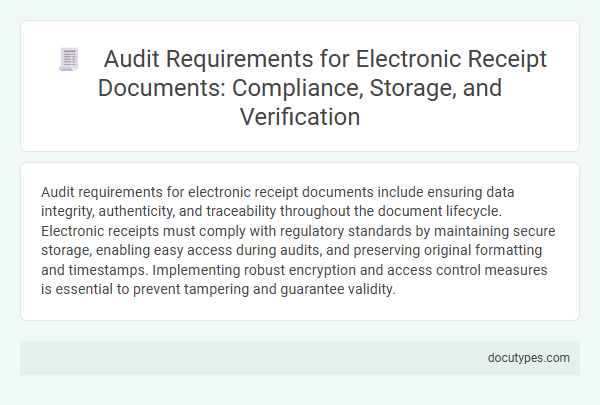Audit requirements for electronic receipt documents include ensuring data integrity, authenticity, and traceability throughout the document lifecycle. Electronic receipts must comply with regulatory standards by maintaining secure storage, enabling easy access during audits, and preserving original formatting and timestamps. Implementing robust encryption and access control measures is essential to prevent tampering and guarantee validity.
Introduction to Electronic Receipt Audit Compliance
Electronic receipt documents require strict audit compliance to ensure accuracy, authenticity, and legal validity. Compliance with these audit requirements supports transparent financial tracking and regulatory adherence in digital transactions.
- Data Integrity - Electronic receipts must maintain unaltered, complete data throughout their lifecycle to pass audit inspections.
- Authentication and Security - Audit compliance requires electronic receipts to incorporate secure authentication methods to verify issuer identity and prevent tampering.
- Retention and Accessibility - Electronic receipts must be stored securely and remain accessible for a legally mandated period to satisfy audit and regulatory demands.
Regulatory Standards for Electronic Receipt Documentation
What are the regulatory standards for electronic receipt documentation in audits? Electronic receipts must comply with standards such as the IRS guidelines, GDPR, and local tax authority regulations to ensure authenticity, integrity, and accessibility. These regulations require that electronic documents are securely stored, tamper-proof, and readily available for audit purposes.
Essential Features of Audit-Ready E-Receipts
Audit requirements for electronic receipt documents mandate secure storage, traceability, and authenticity to ensure compliance with regulatory standards. Essential features of audit-ready e-receipts include tamper-proof records, accurate timestamping, and easy retrieval for verification purposes.
Electronic receipts must incorporate cryptographic signatures to guarantee data integrity and prevent unauthorized modifications. Metadata such as transaction details and user identification should be embedded within the document for comprehensive audit trails. Systems generating e-receipts need reliable backup solutions to protect against data loss during audits.
Legal Requirements for Electronic Receipt Storage
| Aspect | Details |
|---|---|
| Legal Framework | Electronic receipts must comply with local tax laws and electronic transaction regulations such as the eIDAS Regulation in the EU, the IRS guidelines in the USA, or the GST compliance in India. |
| Retention Period | Retention periods vary by jurisdiction; typically, electronic receipt documents must be stored securely for a minimum of 5 to 7 years to meet audit and tax authority requirements. |
| Data Integrity | Receipts must remain unaltered and authentic. Use of digital signatures, hash codes, or encryption ensures data integrity and non-repudiation during the storage period. |
| Accessibility | Electronic receipts should be easily retrievable and readable throughout the retention period, using compatible software and formats acceptable by auditors and regulatory bodies. |
| Backup and Security | Secure storage environments with regular backups protect electronic receipt data from loss, unauthorized access, or corruption. Compliance with standards like ISO/IEC 27001 strengthens audit readiness. |
| Audit Trail | Maintaining a clear audit trail including who accessed or modified the electronic receipt documents supports transparency and compliance during audit reviews. |
Best Practices for Secure E-Receipt Retention
Audit requirements for electronic receipt documents mandate compliant storage and clear accessibility during reviews. Secure retention practices protect data integrity and ensure audit readiness.
- Use Encrypted Storage - Encrypt electronic receipts to prevent unauthorized access and data breaches.
- Implement Access Controls - Restrict receipt document access to authorized personnel only to maintain confidentiality.
- Maintain Immutable Records - Ensure electronic receipts are tamper-evident and preserved in their original form throughout retention periods.
Verification Methods for Electronic Receipts
Audit requirements for electronic receipt documents demand strict verification methods to ensure authenticity and accuracy. These requirements often include validation of digital signatures and timestamp consistency to prevent tampering.
Verification methods for electronic receipts involve cross-referencing transaction data with system logs and payment gateway records. Your audit process should incorporate automated tools that flag discrepancies and maintain a clear audit trail.
Data Integrity and Authenticity in E-Receipts
Audit requirements for electronic receipt documents emphasize maintaining data integrity and authenticity to ensure transaction accuracy and trustworthiness. Electronic receipts must include secure encryption methods and digital signatures to prevent tampering and verify the origin of the document. Audit trails should record all access and modifications, supporting compliance with regulatory standards and safeguarding against fraud.
Audit Trails and Access Controls for Receipt Management
Audit requirements for electronic receipt documents emphasize maintaining comprehensive audit trails and robust access controls. These measures ensure the integrity and security of receipt management processes.
- Audit Trails - Detailed logs must capture all actions related to receipt creation, modification, and deletion to provide a transparent record of document history.
- Access Controls - Role-based permissions restrict receipt access to authorized personnel, minimizing risks of unauthorized viewing or tampering.
- Data Integrity - Systems should implement checksum or encryption methods to preserve receipt authenticity and detect any alterations.
Compliance with these audit standards supports regulatory requirements and enhances organizational accountability in electronic receipt management.
Common Compliance Risks in Electronic Receipt Storage
Audit requirements for electronic receipt documents mandate secure storage, accurate record-keeping, and easy retrieval to comply with regulatory standards such as IRS and Sarbanes-Oxley. Common compliance risks in electronic receipt storage include unauthorized access, data corruption, and failure to maintain audit trails. Ensuring encryption, regular backups, and strict access controls mitigates these risks and supports audit readiness.
What Are the Audit Requirements for Electronic Receipt Documents? Infographic

